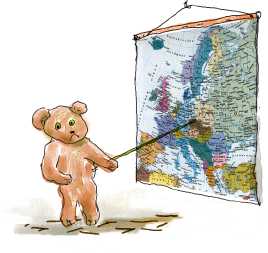
“What is the capital of Romania?” asked the geography teacher a little impatiently as Claudia needed such long time to remember the capital of Belgium.
“Of Romania?” she repeated questioningly.
“Yes,” urged the teacher, “Romania!”
“The capital … of Romania is …”
“Bu-cha-rest!” whispered Benjamin to her, as Claudia had already shot two confused looks at him.
“Budapest!” she finally blurted out.
“Unfortunately, that’s the wrong answer.” said the teacher while shooting Benjamin stern looks. “You should spend less time on Facebook and more time looking at your atlas!”
“But yesterday I memorized all the European capitals at home!” she insisted.
“I believe you! But I can only give you a grade on what you know in the exam,” stated the teacher, and she already sounded a little more forgiving. “You can improve your grade by volunteering for the next oral exercise.”
Who hasn’t already crammed for hours on end until everything was memorized, but then had a total blackout in the exam?
A possible reason for Claudia’s failure in the exam can be due to the fact that the human mind learns associatively. Associative means that different thoughts and ideas in our brains are connected to each other. If a part of one of those connections appears, the other part is also automatically “triggered” in our brains without having to do anything.
If Claudia learns something at home in her room, then not only are the subject that she is learning stored in her mind, but also everything that is within her learning environment. Triggers can be items on her desk or the posters hanging on the wall. Smells or noises can also be important, like aromas coming from the kitchen or noises that are heard while studying. The order of things can also be important for studying, and can connect ideas together like links in a chain.
Associative learning is especially effective when we are learning automatically and without much understanding for a subject – e.g. a list of all the European capitals, all the insect families, or even the leaders of different countries. Very typical and often problematic by learning vocabulary using a vocabulary list is forgetting the translation of a word in a test, and instead remembering the word order on the page. At best, we can exactly remember that the word lies in the bottom left corner of the page, but what the translation is …
Connected learning is very practical as there are many things in life that must be learnt in this manner. Many things are not absolutely logically related to each other. As in Claudia’s case, connected learning can also have negative effects.
If, for example, Claudia is currently memorizing the capital of Romania and her glance falls upon her teddy bear, she would associate the answer “Bucharest” with seeing her teddy bear. However, in the classroom, the geography teacher is sitting across from her, not her teddy bear. As her teacher probably bears little resemblance to the stuffed animal, her eye would probably wander aimlessly around the classroom until she has the luck to catch the glimpse of another pupil who mouths the answer, “Bu-cha-rest”.
The learning environment is always included in one form or another while studying. When remembering a learnt item afterwards, many of the traits of the original learning environment are missing, making the recollection tedious and difficult. Often, the learnt item is completely forgotten afterwards, and can’t be remembered anymore.
 Psychologists have conducted a funny experiment about learning using divers. The divers were required to learn specific subject matter underwater. Later, quizzing the divers on land, they had forgotten almost all of the learnt material. Testing the divers on the same content underwater, they were able to recall almost all the material.
Psychologists have conducted a funny experiment about learning using divers. The divers were required to learn specific subject matter underwater. Later, quizzing the divers on land, they had forgotten almost all of the learnt material. Testing the divers on the same content underwater, they were able to recall almost all the material.
There are several methods to approach the problem of forgetting learnt material outside of the original learning environment. One is to learn each material and review the content in environments that are as different as possible. Another method is to bring as much of the learning environment as possible into the test with you. It is also possible to prepare for an examination by dressing yourself in the same clothes as will be worn in the test – the same shirt and trousers; the same skirt and blouse. Sometimes it helps to have a lucky charm beside you while reviewing for, and during a test. It often also helps when learning for oral exams to stand as if before the class and to imagine with closed eyes the teacher in the class before you.
An especially good learning method is to find images that are independent from learning and test situations. But, that is already another learn tip …